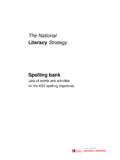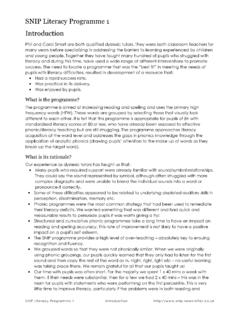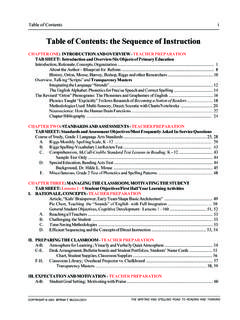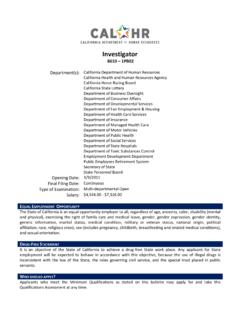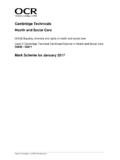Transcription of English Appendix 1: Spelling - UCL Institute of …
1 English Appendix 1: Spelling English Appendix 1: Spelling Most people read words more accurately than they spell them. The younger pupils are, the truer this is. By the end of year 1, pupils should be able to read a large number of different words containing the GPCs that they have learnt, whether or not they have seen these words before. Spelling , however, is a very different matter. Once pupils have learnt more than one way of Spelling particular sounds, choosing the right letter or letters depends on their either having made a conscious effort to learn the words or having absorbed them less consciously through their reading. Younger pupils have not had enough time to learn or absorb the accurate Spelling of all the words that they may want to write. This Appendix provides examples of words embodying each pattern which is taught. Many of the words listed as example words' for years 1 and 2, including almost all those listed as exception words', are used frequently in pupils' writing, and therefore it is worth pupils learning the correct Spelling .
2 The exception words' contain GPCs which have not yet been taught as widely applicable, but this may be because they are applicable in very few age- appropriate words rather than because they are rare in English words in general. The word-lists for years 3 and 4 and years 5 and 6 are statutory. The lists are a mixture of words pupils frequently use in their writing and those which they often misspell. Some of the listed words may be thought of as quite challenging, but the 100 words in each list can easily be taught within the four years of key stage 2 alongside other words that teachers consider appropriate. The rules and guidance are intended to support the teaching of Spelling . Phonic knowledge should continue to underpin Spelling after key stage 1; teachers should still draw pupils'. attention to GPCs that do and do not fit in with what has been taught so far. Increasingly, however, pupils also need to understand the role of morphology and etymology.
3 Although particular GPCs in root words simply have to be learnt, teachers can help pupils to understand relationships between meaning and Spelling where these are relevant. For example, understanding the relationship between medical and medicine may help pupils to spell the /s/ sound in medicine with the letter c'. Pupils can also be helped to spell words with prefixes and suffixes correctly if they understand some general principles for adding them. Teachers should be familiar with what pupils have been taught about Spelling in earlier years, such as which rules pupils have been taught for adding prefixes and suffixes. In this Spelling Appendix , the left-hand column is statutory; the middle and right- hand columns are non-statutory guidance. The International Phonetic Alphabet (IPA) is used to represent sounds (phonemes). A table showing the IPA is provided in this document. 1. English Appendix 1: Spelling Spelling work for year 1.
4 Revision of reception work Statutory requirements The boundary between revision of work covered in Reception and the introduction of new work may vary according to the programme used, but basic revision should include: all letters of the alphabet and the sounds which they most commonly represent consonant digraphs which have been taught and the sounds which they represent vowel digraphs which have been taught and the sounds which they represent the process of segmenting spoken words into sounds before choosing graphemes to represent the sounds words with adjacent consonants guidance and rules which have been taught Statutory Rules and guidance (non-statutory) Example words requirements (non-statutory). The sounds /f/, /l/, The /f/, /l/, /s/, /z/ and /k/ sounds are off, well, miss, buzz, /s/, /z/ and /k/ spelt usually spelt as ff, ll, ss, zz and ck if back ff, ll, ss, zz and ck they come straight after a single vowel letter in short words.
5 Exceptions: if, pal, us, bus, yes. The / / sound spelt bank, think, honk, n before k sunk Division of words Each syllable is like a beat' in the pocket, rabbit, carrot, into syllables spoken word. Words of more than one thunder, sunset syllable often have an unstressed syllable in which the vowel sound is unclear. 2. English Appendix 1: Spelling Statutory Rules and guidance (non-statutory) Example words requirements (non-statutory). -tch The /t / sound is usually spelt as tch if it catch, fetch, kitchen, comes straight after a single vowel notch, hutch letter. Exceptions: rich, which, much, such. The /v/ sound at the English words hardly ever end with the have, live, give end of words letter v, so if a word ends with a /v/. sound, the letter e usually needs to be added after the v'. Adding s and es to If the ending sounds like /s/ or /z/, it is cats, dogs, spends, words (plural of spelt as s. If the ending sounds like rocks, thanks, nouns and the third / z/ and forms an extra syllable or beat' catches person singular of in the word, it is spelt as es.)
6 Verbs). Adding the endings ing and er always add an extra hunting, hunted, ing, ed and er to syllable to the word and ed sometimes hunter, buzzing, verbs where no does. buzzed, buzzer, change is needed The past tense of some verbs may jumping, jumped, to the root word sound as if it ends in / d/ (extra jumper syllable), /d/ or /t/ (no extra syllable), but all these endings are spelt ed. If the verb ends in two consonant letters (the same or different), the ending is simply added on. Adding er and est As with verbs (see above), if the grander, grandest, to adjectives where adjective ends in two consonant letters fresher, freshest, no change is (the same or different), the ending is quicker, quickest needed to the root simply added on. word 3. English Appendix 1: Spelling Vowel digraphs and trigraphs Some may already be known, depending on the programmes used in Reception, but some will be new. Vowel Rules and guidance Example words diagraphs (non-statutory) (non-statutory).
7 And trigraphs ai, oi The digraphs ai and oi are virtually rain, wait, train, paid, afraid never used at the end of English oil, join, coin, point, soil words. ay, oy ay and oy are used for those day, play, say, way, stay sounds at the end of words and at boy, toy, enjoy, annoy the end of syllables. a e made, came, same, take, safe e e these, theme, complete i e five, ride, like, time, side o e home, those, woke, hope, hole u e Both the /u:/ and /ju:/ ( oo' and June, rule, rude, use, tube, tune yoo') sounds can be spelt as u e. ar car, start, park, arm, garden ee see, tree, green, meet, week ea (/i:/) sea, dream, meat, each, read (present tense). ea (/ /) head, bread, meant, instead, read (past tense). er (/ :/) (stressed sound): her, term, verb, person er (/ /) (unstressed schwa sound): better, under, summer, winter, sister ir girl, bird, shirt, first, third ur turn, hurt, church, burst, Thursday 4. English Appendix 1: Spelling Vowel Rules and guidance Example words diagraphs (non-statutory) (non-statutory).
8 And trigraphs oo (/u:/) Very few words end with the food, pool, moon, zoo, soon letters oo, although the few that do are often words that primary children in year 1 will encounter, for example, zoo oo (/ /) book, took, foot, wood, good oa The digraph oa is very rare at the boat, coat, road, coach, goal end of an English word. oe toe, goes ou The only common English word out, about, mouth, around, ending in ou is you. sound ow (/a /) Both the /u:/ and /ju:/ ( oo' and now, how, brown, down, town ow (/ /) yoo') sounds can be spelt as u e, own, blow, snow, grow, show ue ue and ew. If words end in the blue, clue, true, rescue, Tuesday /oo/ sound, ue and ew are more new, few, grew, flew, drew, threw ew common spellings than oo. ie (/a /) lie, tie, pie, cried, tried, dried ie (/i:/) chief, field, thief igh high, night, light, bright, right or for, short, born, horse, morning ore more, score, before, wore, shore aw saw, draw, yawn, crawl au author, August, dinosaur, astronaut air air, fair, pair, hair, chair ear dear, hear, beard, near, year ear (/ /) bear, pear, wear are (/ /) bare, dare, care, share, scared 5.
9 English Appendix 1: Spelling Statutory Rules and guidance Example words (non-statutory). requirements (non-statutory). Words ending y very, happy, funny, party, family (/i:/ or / /). New consonant The /f/ sound is not usually dolphin, alphabet, phonics, elephant spellings ph and spelt as ph in short when, where, which, wheel, while wh everyday words ( fat, fill, fun). Using k for the /k/ The /k/ sound is spelt as k Kent, sketch, kit, skin, frisky sound rather than as c before e, i and y. Adding the prefix The prefix un is added to unhappy, undo, unload, unfair, un the beginning of a word unlock without any change to the Spelling of the root word. Compound Compound words are two football, playground, farmyard, words words joined together. bedroom, blackberry Each part of the longer word is spelt as it would be if it were on its own. Common Pupils' attention should be the, a, do, to, today, of, said, says, exception words drawn to the grapheme- are, were, was, is, his, has, I, you, phoneme your, they, be, he, me, she, we, no, correspondences that do go, so, by, my, here, there, where, and do not fit in with what love, come, some, one, once, ask, has been taught so far.
10 Friend, school, put, push, pull, full, house, our and/or others, according to the programme used 6. English Appendix 1: Spelling Spelling work for year 2. Revision of work from year 1. As words with new GPCs are introduced, many previously-taught GPCs can be revised at the same time as these words will usually contain them. New work for year 2. Statutory Rules and guidance Example words requirements (non-statutory) (non-statutory). The /d / sound spelt The letter j is never used for the /d /. as ge and dge at the sound at the end of English words. end of words, and At the end of a word, the /d / sound badge, edge, bridge, sometimes spelt as g is spelt dge straight after the / /, dodge, fudge elsewhere in words / /, / /, / /, / / and / / sounds before e, i and y (sometimes called short' vowels). After all other sounds, whether age, huge, change, vowels or consonants, the /d / sound charge, bulge, village is spelt as ge at the end of a word.










